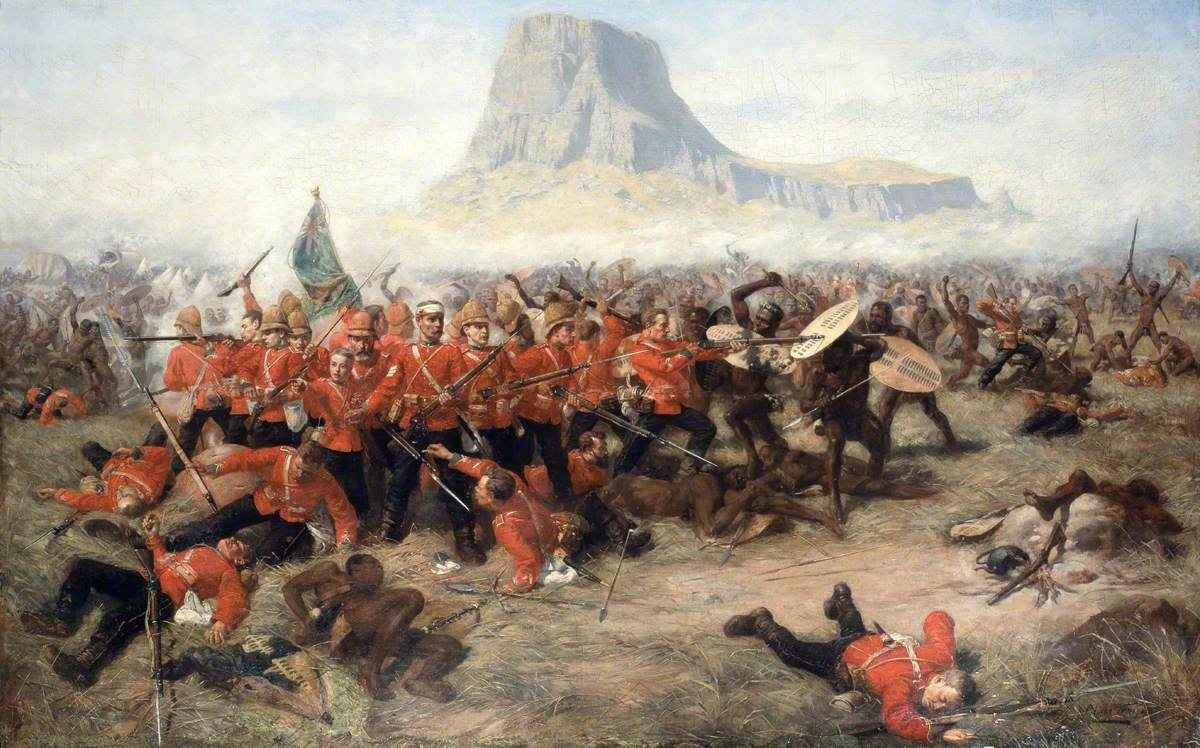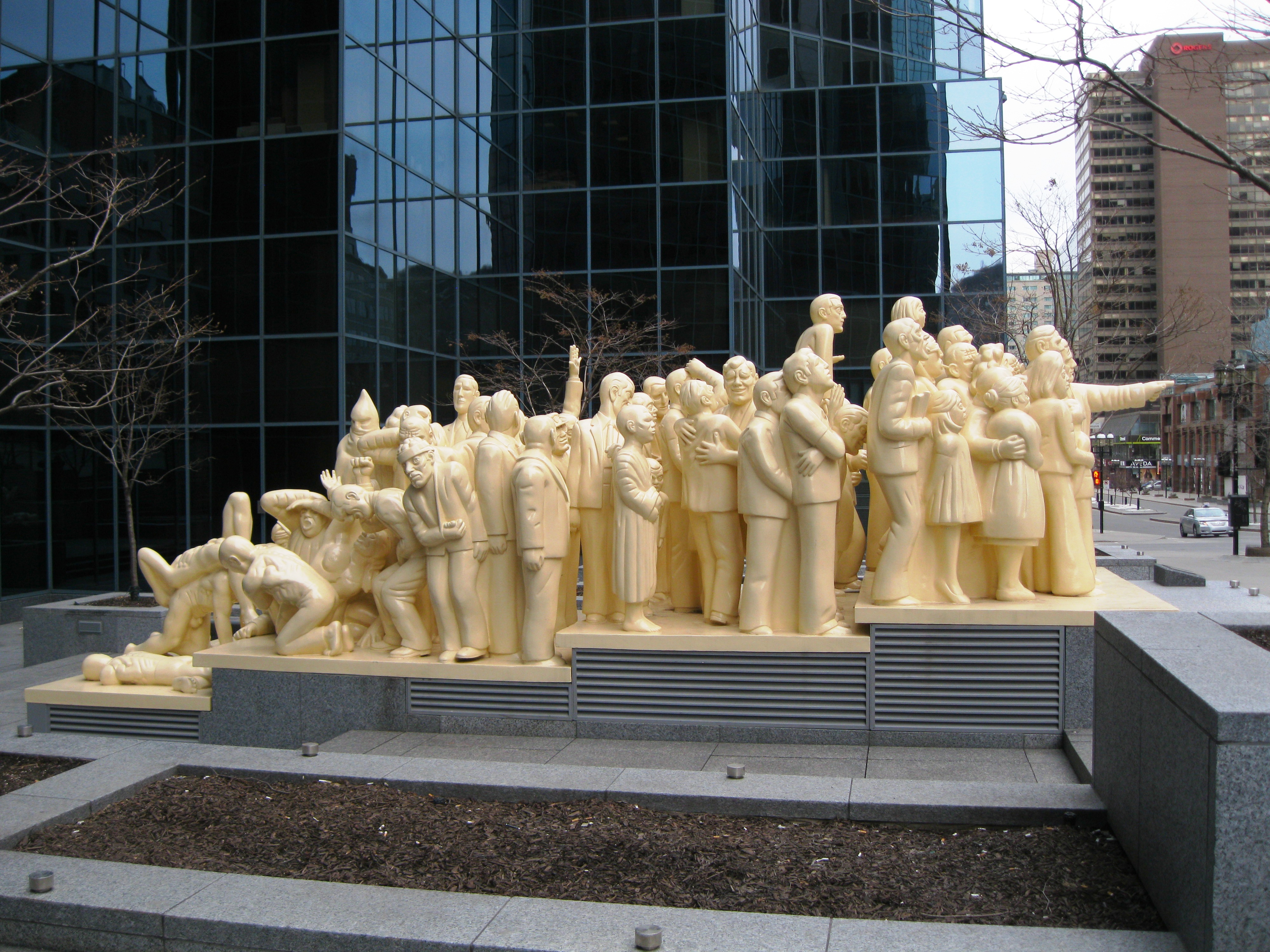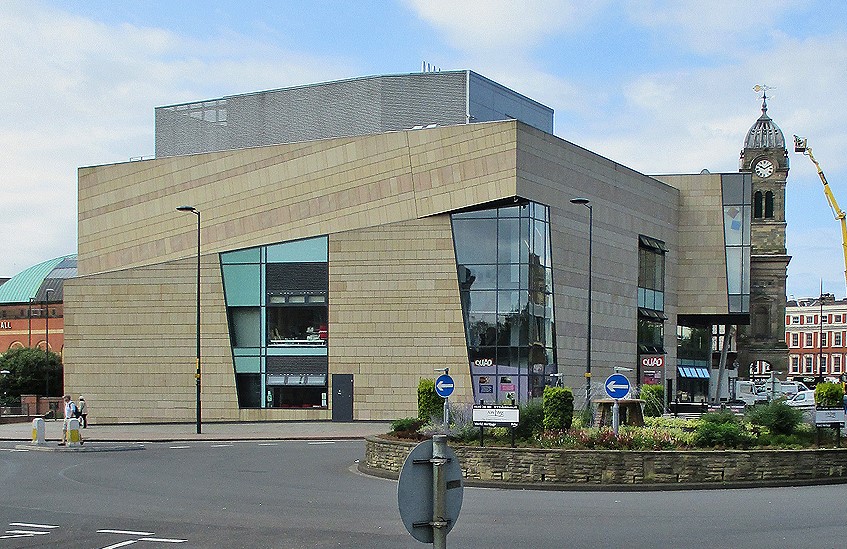|
Derby Central Library
Derby Central Library was the main public and reference library in Derby, England, between 1879 and 2018. It was established in 1879 along with Derby Museum and Art Gallery, with which it shared a red brick building designed in the Domestic Flemish Gothic style by Richard Knill Freeman and given to Derby by Michael Thomas Bass. It was formerly the largest branch of Derby City Libraries run by Derby City Council. History Prior to the Public Libraries Act 1850, a number of circulating libraries existed in Derby. Typically these libraries were run by booksellers and relied on a subscription payment by their members. The "permanent" library in Derby was established in 1811 in Queen Street. This library was open to people who by the 1830s could afford to buy a four guinea share and pay an annual subscription of another guinea. In 1832 this library had 84 members. In 1858, the book collection incorporated the 4,000 volume library of the Derby Philosophical Society. In 1863 the bota ... [...More Info...] [...Related Items...] OR: [Wikipedia] [Google] [Baidu] |
Derby Museum And Art Gallery
Derby Museum and Art Gallery is a museum and art gallery in Derby, England. It was established in 1879, along with Derby Central Library, in a new building designed by Richard Knill Freeman and given to Derby by Michael Thomas Bass. The collection includes a gallery displaying many paintings by Joseph Wright of Derby; there is also a large display of Royal Crown Derby and other porcelain from Derby and the surrounding area. Further displays include archaeology, natural history, geology, military collections and world cultures. The Art Gallery was opened in 1882. History The museum can trace its start to the formation of the Derby Town and County Museum and Natural History Society on 10 February 1836. The society was housed by Full Street Public Baths but it was a private society funded by its members' subscriptions. Its collections were created by donations initially from Dr Forrester who had been a President of Derby Philosophical Society. The patron of the Museum Society ... [...More Info...] [...Related Items...] OR: [Wikipedia] [Google] [Baidu] |
Henry Howe Bemrose
Sir Henry Howe Bemrose (19 November 1827 – 4 May 1911) was a British printer and publisher, as well as mayor and later Conservative Member of Parliament for Derby. Life Bemrose was the first son of William Bemrose, and was educated at Derby School and King William's College, in the Isle of Man. He and his brother William jnr became partners in his father's printing firm in Derby in 1858. He took over as chairman of the family firm of ''William Bemrose & Sons'', printers of Derby and London and was a director of Parr's Derby Bank. He was active in many walks of public life, including the church and charitable organisations. After serving as Mayor of Derby in 1877–1878, he became Member of Parliament for Derby from 1895 to 1900. In 1855, he married Charlotte, daughter of William Brindley, of Derby. They had one son and five daughters. The son, also named Henry (b. 1857), but known as Arnold, came into the family printing business in 1879. Henry senior was the grandfather of ... [...More Info...] [...Related Items...] OR: [Wikipedia] [Google] [Baidu] |
Cultural Infrastructure Completed In 1878
Culture () is an umbrella term which encompasses the social behavior, institutions, and norms found in human societies, as well as the knowledge, beliefs, arts, laws, customs, capabilities, and habits of the individuals in these groups.Tylor, Edward. (1871). Primitive Culture. Vol 1. New York: J.P. Putnam's Son Culture is often originated from or attributed to a specific region or location. Humans acquire culture through the learning processes of enculturation and socialization, which is shown by the diversity of cultures across societies. A cultural norm codifies acceptable conduct in society; it serves as a guideline for behavior, dress, language, and demeanor in a situation, which serves as a template for expectations in a social group. Accepting only a monoculture in a social group can bear risks, just as a single species can wither in the face of environmental change, for lack of functional responses to the change. Thus in military culture, valor is counted a typical ... [...More Info...] [...Related Items...] OR: [Wikipedia] [Google] [Baidu] |
Libraries Established In 1879
A library is a collection of materials, books or media that are accessible for use and not just for display purposes. A library provides physical (hard copies) or digital access (soft copies) materials, and may be a physical location or a virtual space, or both. A library's collection can include printed materials and other physical resources in many formats such as DVD, CD and cassette as well as access to information, music or other content held on bibliographic databases. A library, which may vary widely in size, may be organized for use and maintained by a public body such as a government; an institution such as a school or museum; a corporation; or a private individual. In addition to providing materials, libraries also provide the services of librarians who are trained and experts at finding, selecting, circulating and organizing information and at interpreting information needs, navigating and analyzing very large amounts of information with a variety of resources. Li ... [...More Info...] [...Related Items...] OR: [Wikipedia] [Google] [Baidu] |
1879 Establishments In England
Events January–March * January 1 – The Specie Resumption Act takes effect. The United States Note is valued the same as gold, for the first time since the American Civil War. * January 11 – The Anglo-Zulu War begins. * January 22 – Anglo-Zulu War – Battle of Isandlwana: A force of 1,200 British soldiers is wiped out by over 20,000 Zulu warriors. * January 23 – Anglo-Zulu War – Battle of Rorke's Drift: Following the previous day's defeat, a smaller British force of 140 successfully repels an attack by 4,000 Zulus. * February 3 – Mosley Street in Newcastle upon Tyne (England) becomes the world's first public highway to be lit by the electric incandescent light bulb invented by Joseph Swan. * February 8 – At a meeting of the Royal Canadian Institute, engineer and inventor Sandford Fleming first proposes the global adoption of standard time. * March 3 – United States Geological Survey is founded. * March 11 – The Ry ... [...More Info...] [...Related Items...] OR: [Wikipedia] [Google] [Baidu] |
Public Libraries In Derbyshire
In public relations and communication science, publics are groups of individual people, and the public (a.k.a. the general public) is the totality of such groupings. This is a different concept to the sociological concept of the ''Öffentlichkeit'' or public sphere. The concept of a public has also been defined in political science, psychology, marketing, and advertising. In public relations and communication science, it is one of the more ambiguous concepts in the field. Although it has definitions in the theory of the field that have been formulated from the early 20th century onwards, and suffered more recent years from being blurred, as a result of conflation of the idea of a public with the notions of audience, market segment, community, constituency, and stakeholder. Etymology and definitions The name "public" originates with the Latin '' publicus'' (also '' poplicus''), from ''populus'', to the English word 'populace', and in general denotes some mass population ("the p ... [...More Info...] [...Related Items...] OR: [Wikipedia] [Google] [Baidu] |
Buildings And Structures In Derby
A building, or edifice, is an enclosed structure with a roof and walls standing more or less permanently in one place, such as a house or factory (although there's also portable buildings). Buildings come in a variety of sizes, shapes, and functions, and have been adapted throughout history for a wide number of factors, from building materials available, to weather conditions, land prices, ground conditions, specific uses, prestige, and aesthetic reasons. To better understand the term ''building'' compare the list of nonbuilding structures. Buildings serve several societal needs – primarily as shelter from weather, security, living space, privacy, to store belongings, and to comfortably live and work. A building as a shelter represents a physical division of the human habitat (a place of comfort and safety) and the ''outside'' (a place that at times may be harsh and harmful). Ever since the first cave paintings, buildings have also become objects or canvasses of much artist ... [...More Info...] [...Related Items...] OR: [Wikipedia] [Google] [Baidu] |
Derby QUAD
Quad (branded as QUAD and also known as Derby QUAD), is an arts centre in Derby, England, first opened on 26 September 2008. Quad provides an art gallery, three cinemas (two large cinemas and a smaller relaxed room known as "The Box" showing small lesser known films), artists’ studios, and a cafe bar. The centre also has spaces in which people can create their own artwork. The building has a steel-and-glass design by Bath architects Feilden Clegg Bradley, which was considered controversial when it was chosen by Derby council cabinet in 2004. BBC Derby, accessed September 2009 Details [...More Info...] [...Related Items...] OR: [Wikipedia] [Google] [Baidu] |
Listed Buildings In Derby (Arboretum Ward)
Arboretum (ward), Arboretum is an Wards of the United Kingdom, electoral ward in the city of Derby, England. The ward contains over 150 Listed building#England and Wales, listed buildings that are recorded in the National Heritage List for England. Of these, three are listed at Grade I, the highest of the three grades, 12 are at Grade II*, the middle grade, and the others are at Grade II, the lowest grade. The ward contains the centre of the city and an area to the south, including Rose Hill. Most of the listed buildings are houses and associated structures, shops, offices, public buildings, banks, public houses and hotels. In the area near the railway stations is accommodation built for railway workers, now listed, and to the south of the centre is Derby Arboretum, which contains a variety of listed buildings. The other listed buildings include Derby Cathedral, churches and associated structures, a former grammar school, a set of wrought iron gates by ... [...More Info...] [...Related Items...] OR: [Wikipedia] [Google] [Baidu] |
Council House, Derby
The Council House is a municipal building in Corporation Street, Derby, England. It is a locally listed building. History The facility was commissioned to replace the Guildhall in the Market Place. The site chosen for the new building was previously occupied by riverside wharves and industrial premises. Work started on the new building, which was designed by Charles Aslin, in the Neo-Georgian style, in 1938 and the part-built facility was then requisitioned by the Air Ministry during the Second World War. The original plan had involved an oval council chamber to the south of the main building as well as a clock tower but both these aspects of the proposals were abandoned. Conversely proposals for a large portico incorporating four Palmyrene columns and a pediment above were retained. The design of the Mayor's Chamber incorporated oak panelling recovered from Derwent Hall before it was demolished to make way for the Ladybower Reservoir in 1942. The construction work was complete ... [...More Info...] [...Related Items...] OR: [Wikipedia] [Google] [Baidu] |
Alfred E
Alfred may refer to: Arts and entertainment *'' Alfred J. Kwak'', Dutch-German-Japanese anime television series * ''Alfred'' (Arne opera), a 1740 masque by Thomas Arne * ''Alfred'' (Dvořák), an 1870 opera by Antonín Dvořák *"Alfred (Interlude)" and "Alfred (Outro)", songs by Eminem from the 2020 album '' Music to Be Murdered By'' Business and organisations * Alfred, a radio station in Shaftesbury, England * Alfred Music, an American music publisher * Alfred University, New York, U.S. * The Alfred Hospital, a hospital in Melbourne, Australia People * Alfred (name) includes a list of people and fictional characters called Alfred * Alfred the Great (848/49 – 899), or Alfred I, a king of the West Saxons and of the Anglo-Saxons Places Antarctica * Mount Alfred (Antarctica) Australia * Alfredtown, New South Wales * County of Alfred, South Australia Canada * Alfred and Plantagenet, Ontario * Alfred Island, Nunavut * Mount Alfred, British Columbia United States * A ... [...More Info...] [...Related Items...] OR: [Wikipedia] [Google] [Baidu] |
Town Hall
In local government, a city hall, town hall, civic centre (in the UK or Australia), guildhall, or a municipal building (in the Philippines), is the chief administrative building of a city, town, or other municipality. It usually houses the city or town council, its associated departments, and their employees. It also usually functions as the base of the mayor of a city, town, borough, county or shire, and of the executive arm of the municipality (if one exists distinctly from the council). By convention, until the middle of the 19th century, a single large open chamber (or "hall") formed an integral part of the building housing the council. The hall may be used for council meetings and other significant events. This large chamber, the "town hall" (and its later variant "city hall") has become synonymous with the whole building, and with the administrative body housed in it. The terms "council chambers", "municipal building" or variants may be used locally in preferen ... [...More Info...] [...Related Items...] OR: [Wikipedia] [Google] [Baidu] |









